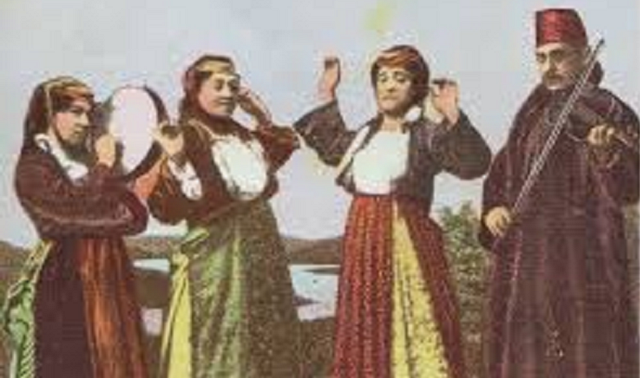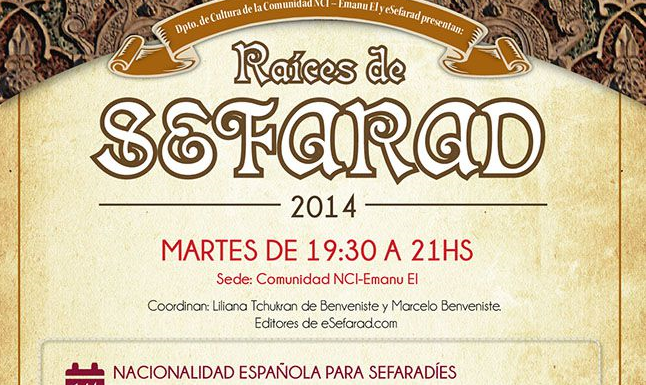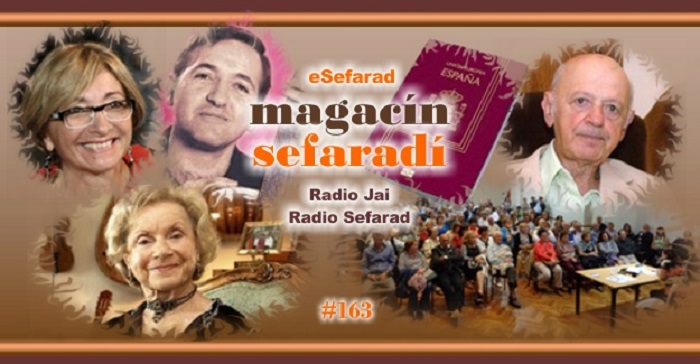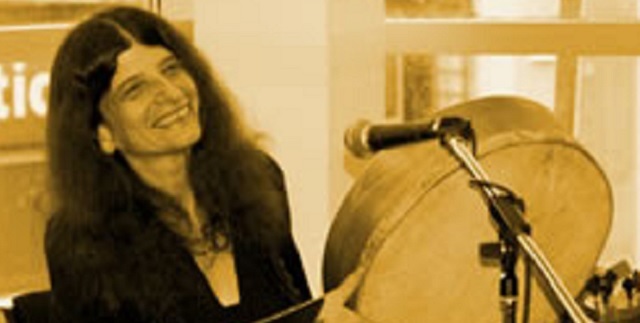EMPEZAR QUIERO CONTAR, CON JUDITH COHEN – Hola, buenos días. Aquí Judith Cohen, desde Canadá. La última vez que estuvimos juntos aquí en Radio Sefarad os hablé de mis primeros encuentros con las canciones sefardíes. Hoy entramos en el mundo seductor del romancero. En el primer programa os presenté un fragmento de Landarico, el primer romance que recopilé. Me lo cantó la señora Mercedes Bohbot – que descanse en paz– de Larache, Marruecos, en un encuentro de gente mayor judía en las afueras de mi ciudad natal, Montreal, Canadá.
Se trata de una historia muy antigua. Nos ha llegado desde la época lejana de los merovingios, del siglo VI, por la Gesta Regum Francorum, la crónica de los hechos de los reyes Francos. El amante Landarico del romance – Landericus – era el criado de la reina Fredegunda, esposa del rey Chilperic. El nombre de Landarico se ha mantenido – Andarlino, en Bosnia Andarleto, en Portugal Andarilho. La historia en forma de romance es más tardía, del siglo XVI, y se canta con varias melodías que proceden de varios lugares y varias épocas: no se puede, de momento asignar una fecha concreta. Hoy en día, el romance es cantado todavía por los sefardíes de Marruecos, los sefardíes de la zona ex otomana – Turquía, Bulgaria y otros – y, muy de vez en cuando, se encuentra también en España y Portugal. Las versiones varían – son más o menos violentas, muere Landarico o la reina, o no… Cuando el rey saluda a la reina por la mañana, ésta se está peinando o mirándose al espejo. No le mira porque piensa que tiene que ser su amante – el criado Landarico – y le dice que tiene tres hijos con él y solamente uno con el rey – o a veces son dos y dos –; luego explica que a los niños de su amante se les da todo lo mejor, y el o los del rey quedan en segundo lugar …. Cuando la reina deja de mirarse en el espejo ve a su marido el rey, intenta disculparse – diciendo “estaba loca” o “ha sido un sueño….”. En algunas versiones, el rey mata primero a Landarico; en otras, le corta la lengua a la reina o le da un “yardán corolado” – un collar rojo, o sea se le corta la cabeza.
Ya hemos escuchado una versión típica sefardí marroquí. Ahora vamos a escuchar dos versiones de la zona ex otomana. Primero, el gran Haim Effendi (Haim Behar Menahem, de Edirne, Turquia, nacido en 1853 y fallecido en 1938. Sus grabaciones ya tienen, algunas, cien años; han sido entre las primeras grabaciones de la música sefardí).
Y ahora, Flory Jagoda, la muy querida “nona” de las canciones sefardíes de su Bosnia natal. Esta versión, de su primer disco, tiene un estilo diferente de su famosa canción “Ocho kandelikas”.
Existe una confusión – especialmente entre los aficionados a la música sefardí que no hablan el castellano – entre lo que es un romance y lo que no, y también entre un romance y una “romansa”. El romance, como sabéis la mayoría de vosotros, es esencialmente una canción narrativa con cierta estructura, lo que en inglés se llama un “ballad” o “narrative ballad”. Los sefardíes del norte de Marruecos en general dicen “romance” en el mismo sentido. Los sefardíes del Mediterráneo oriental, de las zonas ex otomanas, antes también entendían lo mismo por la palabra “romansa”, pero en algún momento empezaron a llamar “romansa” a casi cualquier canción de tema amoroso – romántico. Muchos discos de música sefardí llevan títulos como “joyas del romancero sefardí”, cuando el disco no incluye ni un solo romance.
Hay tantos romances llamativos que no sé cuáles escoger. Muchos se cantan en ambas tradiciones sefardíes – de Marruecos y la región ex otomana – y a veces, incluso hoy día, en España, también en Portugal, en América Latina, Italia o en alguna versión pan-europea. Otros romances son cantados únicamente entre los sefardíes del norte de Marruecos o entre los del Mediterráneo occidental.
Un contexto clásico del romancero es, o era, cantarlo como canción de cuna. Algunos – pocos – se cantan para las bodas, como, en Marruecos, “Raquel lastimosa”; otros, los más tristes, como lamentos o endechas. En Marruecos, eran cantados también por las mozas en la primavera, justo antes de la Pascua judía, cuando montaban un columpio en el patio interior de la casa, y las jóvenes cantaban mientras se columpiaban. Las chicas distinguían entre los romances “de columpio” o de “matesha”, y los que no eran de matesha. Para cambiar el turno de una moza a otra, se servían de una rima, en una mezcla de castellano y árabe marroquí. Aquí la Tía Dorna me lo explica en Tetuán, en los años 90.
Entre los romances de columpio o de matesha, un clásico era Diego León. La voz que vais a escuchar aquí es la de Ester Roffé. Ella es de Alcazarquivir – Ksar-al-Kibir, pero lleva muchos años en Caracas, Venezuela, donde tuve la buena suerte de conocerla en los años 80 – yo cantaba con el grupo Gerineldo y la comunidad de Caracas nos invitó a actuar. Lo curioso es que, dado que Ester Roffe y sus músicos añaden un pequeño interludio entre una estrofa y otra, se pierde el movimiento continuo del columpio.
La pregunta es ¿son o no “medievales” los romances? Hablemos de tres elementos de un romance: la historia, las letras, y la melodía. Muchas de las historias sí que son antiguas, incluso de antes de la Edad Media europea. La forma, la estructura, el género que identificamos como “romance” no aparece hasta las primeras décadas del siglo XV: hay una versión de “La dama y el pastor” cuya letra apuntó un estudiante mallorquín en el año 1421. Pero otros romances no aparecen hasta después de la Expulsión, y los sefardíes los habrán aprendido cuando estaban ya fuera de España – quizás por la llegada de conversos o de boca de viajeros. Los sefardíes también adaptaban canciones narrativas de sus vecinos griegos… y en Marruecos aprendían nuevas versiones del romancero durante los años del Protectorado español. O sea, hablando de la letra, los hay más – y menos – antiguos. Pero en cuanto a las melodías, hasta finales del siglo XIX no tenemos éstas transcritas. No sabemos hasta qué momento podemos seguir la cadena de trasmisión. En muchos manuscritos antiguos de canciones religiosas, existe la indicación – un íncipit, un primer verso – o sea, la instrucción “a cantar con la melodía de tal u otro romance”, pero –no sabemos cuáles eran estas melodías.
Vamos a escuchar un romance que se refiere a un acontecimiento del año 1497, cinco años después de la Expulsión, pero un año antes de la salida final de tierras ibéricas, del reino de Navarra. Se trata del asesinato del Duque de Gandía – Juan Borgia, o Borja, hijo de Rodrigo Borgia –, el Papa Alejandro VI. El romance relata el hallazgo del cuerpo del ahogado, con su ropa cara y sus joyas intactas, aunque no le nombra. Tal vez fue compuesto por los sefardíes que habían llegado hasta Italia. Se ha recogido tanto entre los judíos de Marruecos como entre los de la zona ex otomana, y la versión más bonita, a mi parecer, es la que canta Berta, o Bienvenida Aguado (que nació en Canakkale, Turquia, y vive desde hace muchos años en Bat Yam, al sur de Tel Aviv). Hay grabaciones de Berta en la gran colección de la etnomusicóloga Susana Weich-Shahak, cuyo trabajo tanto admiramos todos sus colegas; también en la colección de Radio Kol Israel y de otros (he tenido el privilegio de grabar a Berta un par de veces en directo).
Un romance cuyo tema forma parte de muchas canciones y leyendas, en varios países y culturas del mundo es “La doncella guerrera”: la muchacha que se disfraza de mozo para ir a la guerra. Es cantada por los judíos de Marruecos, además de en España, Portugal, Inglaterra y en otros países: aquí escuchemos la magnífica versión del gran jazán Isaac Algazi, de Turquía (1889-1960), de la primera mitad del siglo XX.
Casi se acaba esta segunda entrega. En la próxima, escucharemos algunas canciones del ciclo de la vida. Hasta entonces, saludos desde Canadá, a todos los de Radio Sefarad, y a todos vosotros oyentes, de vuestra amiga Judith Cohen.
[TEXT IN ENGLISH:
EMPEZAR QUIERO CONTAR, WITH JUDITH COHEN 2. Narrative ballads: romances
Hi, I’m Judith Cohen, speaking to you from Canada. The last time we were here at Radio Sefarad together, I told you about my first encounters with Sephardic songs. Today we enter the seductive world of romances, narrative ballads. In my first programme I presented a fragment of Landarico, the first romance I ever recorded in fieldwork. It was sung to me by Mercedes Bohbot – may she rest in peace – of Larache, Morocco, during a Yiddish song session with Jewish Senior Citizens in a summer camp outside my home town of Montreal.
Landarico tells a very old story. It came down to us from the distant time of the Merovingians, in the sixth century, in the Gesta Regum Francorum, the “Deeds of the Frankish Kings.” The lover in the ballad, Landarico – landericus in the original – was a servant of Queen Fredegunda, the wife of King Chilperic. The name “Landarico” remained in the ballad through the centuries: as Andarlino, or in Bosnia Andarleto, and in Portugal Andarilho. The story in ballad form is considerably later than the old narrative; in fact, the first manuscript does not appear until the 16th century, though of course oral versions will have circulated well before that. It’s sung to various melodies, from various times and places – at the moment, no one date can be assigned to any of them. Today, this ballad is still sung by Sephardim from Morocco, and from the Ottoman region – Turkey, Bosnia, and others – and, very occasionally, can still be found in Spain and Portugal. Versions vary: more or less violent, Landarico and/or the Queen die or do not die… When the King greets the Queen early one morning, she is combing her hair, often looking in the mirror. She doesn’t look at him because she assumes it is her lover, her servant Landarico, and she imprudently talks to him of their three illegitimate children, and only one with the king (sometimes, it’s two and two). She then goes on to say that her children with Landarico have the best of everything and the king’s must be content with whatever’s left. Finally, she turns from the mirror, and realizes she’s been talking to her royal husband. She tells him “oh, I must have been temporarily out of my mind” or, in other versions, “it was just a dream”. In some versions, the King first finds and kills Landarico, while in others he cuts out the Queen’s tongue or tells her he will give her a “ruby necklace”, i.e. cut off her head. Last week, we heard a typical Moroccan version. Now we’ll hear two versions from Ottoman regions: first, the legendary Haim Effendi (Haim Behar Menahem, from Edirne, Turkey, 1853-1938.) Some of his recordings are already over a century old: he was one of the first Sephardim of the then-new recording industry. – And now, Flory Jagoda, the beloved “nona” (grandmother) of the Sephardic songs of her native Bosnia-Hercegovina. This version, from her first album, is sung in a very different style from Flory’s famous song “Ocho kandelikas”.
There is often some confusion, especially among non-Spanish speakers, about what is and isn’t a romance, and what is and isn’t a romansa. As most Spanish speakers know, a romance is basically a narrative ballad with one of a few established structures. Northern Moroccan Sephardim usually use the word “romance” in this sense. Sephardim from the eastern Mediterranean, Ottoman, areas used to use the word “romansa” in this sense as well, but at some point began to use the word to refer to almost any song with a romantic feel. Also, the romancero is the corpus of romances, but many people mistakenly refer to it in English as if it meant “one romance.” Sephardic albums may have names such as “Jewels of the Sephardic romancero” when in fact there is not one romance among the songs.
There are so many wonderful romances that it’s hard to know which ones to choose. Many are sung in both western (Morocco) Mediterrnean and eastern (Ottoman region) traditions, and sometimes as well in Spain and Portugal, Latin America, Italy and even in pan-European ballad traditions in various languages. Others are found only among Sephardim, or only among Sephardim and in Spain, or only among Sephardim from one region or another. One classic function of the romance is as a lullaby; a few are used as part of the wedding repertoire, such as the well-known Moroccan “Raquel Lastimosa”; still others as laments. In Morocco, they were often sung by young unmarried girls in the early spring, before Passover, when a swing would be put up in a house’s inner courtyard, and the girls would sing romances as they took a turn swinging. In fact, the distinguished between ballads which were for swinging – “de columpio” or “de matesha”, borrowing from a local Arabic word; and those which were not suited for swinging, mostly on the basis of the rhythm of the melody. To signal the moment when the girl on the swing would surrender it to the next girl, they often used a rhyme in a mixture of Spanish and daridzha, Moroccan Arabic. Here is Tía Dorna, Auntie Dorna, explaining this to me in Tetuan, in 1990.
Among the ballads used for swinging, “de columpio” o “de matesha”, one classic was un clásico Diego León. Here it’s sung by Ester Roffé. Originally from the town of Alcazarquivir, or Ksar-al-Kibir, she has lived most of her life in Caracas, Venezuela, where I had the good fortune to meet her in the 1980s, when I was singing with Gerineldo, and the Sephardic community of Caracas had invited us to perform. Curiously, while Ester Roffe’s vocal style is traditional, inserting an instrumental interlude between the stanzas results in the typical cyclical nature of the melody being lost, along with its suitability for the continuous movement of the swing.
There is a common assumption that all romances are “medieval.” Are they? I think we need to identify three main elements in a sung romance, narrative ballad: the story it tells, the words of the song, and the melody it’s sung to. Many of the stories are indeed very old, some, like Landarico, from the very early Middle Ages, or even before that. But the poetic form and structure of the romance do not appear, at least in written form, until the early fifteenth century, already the end of the medieval period, or the beginning of the Renaissance, or Early Modern period, depending on which scholarly system is assigning the names of these epochs. Indeed, many romances only appear in manuscripts and early printed documents, after the expulsion of the Jews from Spain. The first is commonly thought to be a version of “The lady and the shepherd”, still found in oral tradition, whose words were written down by a Mallorcan student in 1421. Perhaps Sephardim learned these before the expulsion, if the songs were already circulating orally, or perhaps, in some cases, they were learned from travelers, or from Jews who left Spain or Portual as New Christians, and were able to return to open Judaism in Constantinople (Istanbul), or Salonica or other centres. Sephardim also adapted narrative songs from their neighbours, in Greek, for example. In Morocco, they sometimes learned new melodies for old romances during the decades of the Spanish Protectorate. In any case, for actual melodies, as far as we know, there are no surviving written melodies until the late 19th century. We can speculate, but we can’t really know how far back the chain of oral transmission of a given melody can be traced. In several collections of piyyutim, Hebrew metrical hymns, an indication is given of the melody to be used, often a ballad, but without the actual melody, just an indication such as “to be sung to the tune of – “.
Let’s listen to a romance which refers to an event that took place in 1497, five years after the Expulsion – but actually one year before the last expulsion of Iberian Jews, in 1498, from Navarre. The words, although they don’t use the name, refer to the assassination of the Duque of Gandía – Juan Borgia, or Borja – son of Rodrigo Borgia, who was Pope Alexander VI. The words relate the discovery of the corpse of the drowned man, with his fine clothing and jewellery intact. Perhaps the ballad was composed by Sephardim who had reached Italy and stayed there, at least for some time, some permanently. It’s been recorded among Sephardim of both Morocco and the Ottoman regions, especially Turkey, and perhaps the most beautiful version is one sung by Berta, or Bienvenida Aguado. Born in Canakkale, Turkey, she lived, until her recent passing, in Bat Yam, south of Tel Aviv. Fortunately, there are many recordings of her besides the few I was fortunate to make myself; many from the collection of the great ethnomusicologist, my colleague and friend Susana Weich-Shahak, also in the collection of Radio Kol Israel and others.
One ballad which is part of many songs and stories, in several countries, cultures and languages, is the “Warrior Maiden”, “La doncella guerrera”, the girl who disguises herself as a male soldier and goes off to the wars. It’s sung by Sephardim on both sides of the Mediterranean, and there are many versions in Spain, Portugal, England, France and elsewhere. Here is a magnificent version sung by the great Hazzan Isaac Algazi, of Izmir, Turkey (1889-1960), recorded in the first half of the 20th century.
And with this recording ends the second in this series. In the next section, we’ll hear some songs of the Sephardic life cycle. Till then, greetings from Canada to everyone at Radio Sefarad and all you listeners, from your friend Judith Cohen. ]




